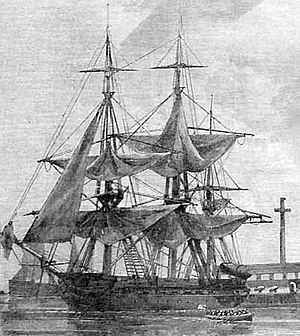USS Vandalia (1828)

USS Vandalia in 1861
|
|
| History | |
|---|---|
|
|
|
| Name: | USS Vandalia |
| Builder: | Philadelphia Navy Yard |
| Laid down: | 1825 |
| Launched: | 1828 |
| Commissioned: | 6 November 1828 |
| Decommissioned: | 4 February 1863 |
| Fate: | Broken up, between 1870 and 1872 |
| General characteristics | |
| Type: | Sloop-of-war |
| Displacement: | 614 long tons (624 t) |
| Length: | 127 ft 4 in (38.81 m) |
| Beam: | 34 ft 6 in (10.52 m) |
| Draft: | 16 ft 6 in (5.03 m) |
| Propulsion: | Sail |
| Complement: | 150 officers and enlisted |
| Armament: |
|
The first Vandalia was an 18-gun sloop-of-war in the United States Navy during the Second Seminole War and the American Civil War. She was named for the city of Vandalia, Illinois.
Vandalia was laid down at the Philadelphia Navy Yard in 1825; launched in 1828; and commissioned on 6 November of that year, Commander John Gallagher in command.
Vandalia left Philadelphia on 16 December 1828, bound for duty with the Brazil Squadron off the eastern seaboard of South America. She remained off the coasts of Brazil and Argentina for the next three years, during a period of political unrest on the continent of South America. She returned to Norfolk, Virginia, on 18 December 1831; was decommissioned the next day.
Vandalia remained inactive until 4 October 1832 when she was recommissioned for service with the West Indies Squadron. Vandalia again put into Norfolk in August 1834 and was decommissioned there on the 24th for major repairs. Recommissioned on the last day of the year, she joined the West Indies Squadron in January 1835 and served with that organization into the summer of 1838; cooperating with land forces in Florida during the Second Seminole War; and helping to suppress piracy and the slave trade. After almost three months laid up undergoing repairs from 30 August to 24 November, the ship was reactivated and returned to duty for a year in the Caribbean. Nearing five years in its current service, and now being unseaworthy, it returned to Hampton Roads, Virginia, where her commissioning pennant was again hauled down at Norfolk on 23 November 1839.
Following more than two years on the stocks, the ship was returned to commission on 3 February 1842, joined the newly created Home Squadron in 1842, and performed routine patrol and reconnaissance duties at scattered points as far north as Newfoundland and as far south as the mouth of the Amazon River. During a visit to Haiti in the early spring of 1845, an epidemic of yellow fever broke out in the ship. She returned immediately to Norfolk, was decommissioned on 30 April, and was laid up.
...
Wikipedia
